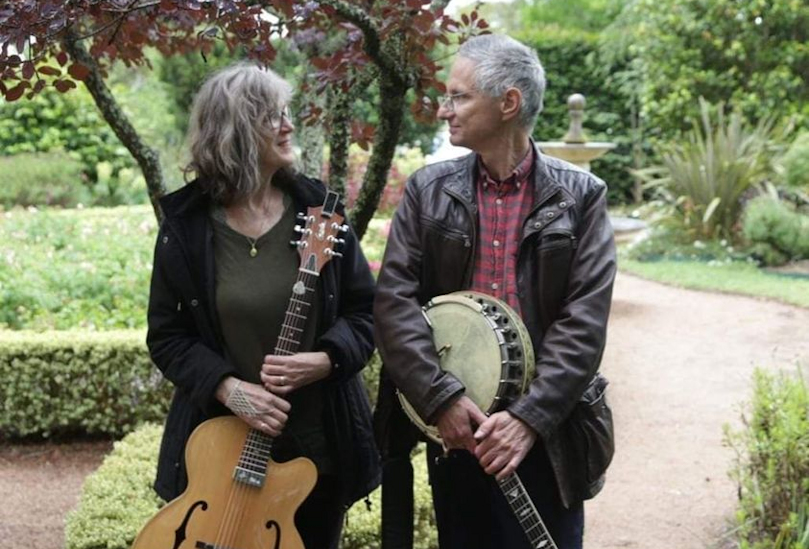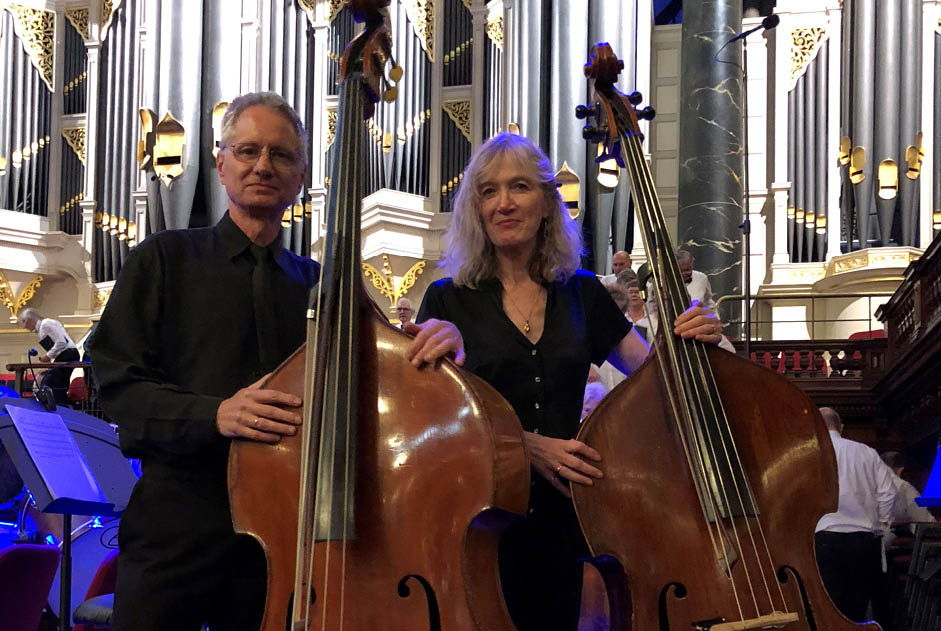How phage therapy saved this musician from a life-threatening infection
With only weeks to live, talented musician Paul Laszlo received cutting edge phage therapy which successfully treated his severe chest infection and saved his life.

When he experienced breathing issues in 2017, Paul Laszlo, then 63, thought he had developed adult-onset asthma. But after seeing his GP and undergoing tests, the professional musician was shocked to learn he had mesothelioma, an aggressive cancer caused by asbestos. The cancer was growing on his left side in the pleura – the tissue surrounding the lung. “I think the asbestos exposure occurred in my 20s when I was doing up old cars,” says Laszlo who lives in the Blue Mountains of NSW. Within weeks of the diagnosis, he underwent surgical treatment to contain and arrest the cancer.
Eleven months later the lung had filled with four and a half litres of fluid, which needed to be dealt with by a different medical team. Soon afterwards, Laszlo’s cancer also required further treatment. “Several times, Paul was told he should go home and prepare to die, but we never gave up researching specialists and treatments,” says Ann Palumbo, his life and musical partner for 23 years. “So, in 2018, we asked to be referred to Professor Tristan Yan at the Chris O’Brien Lifehouse in Sydney.” Yan performed extensive and complex surgery to remove Laszlo’s left lung and surrounding tissue. Chemotherapy and radiation were also used. The combined approach was successful in treating the cancer. Unfortunately, Paul then experienced a major complication.
Living with a life-threatening infection
In 2019, a dangerous bacterial infection developed in the chest cavity created by Laszlo’s surgery. For the next three years he felt trapped on a merry-go-round of endless medical treatment that included over 20 surgical procedures and also, ongoing courses of different antibiotics. “Though the antibiotics helped keep me alive, the bacteria kept multiplying,” Laszlo explains. “So, my weeping wound often had to be left open, covered with dressings and bandages that quickly became wet. I constantly had to drain the wound using special equipment. I was so unwell and exhausted from the infection that I couldn’t even carry my double bass to or from the car and though I love my job of performing music, to get up on stage was challenging.”
Laszlo’s severe infection kept progressing despite all attempts to manage it. So, in 2020, as a last resort, his infection specialist referred him to Professor Jon Iredell, Director of the Centre for Infectious Diseases and Microbiology at Westmead Hospital, to be considered for bacteriophage (“phage”) therapy. The treatment uses viruses that are described as being the most abundant organisms on Earth.
Rising to the challenge of antimicrobial resistance
Phage therapy in NSW is supported by the Office for Health and Medical Research through direct funding for phage treatments. Phage therapies are being produced on site at the Westmead Institute for Medical Research. They are being made under the Therapeutic Goods Administration’s Special Access Scheme guidelines. Engagement with national regulatory bodies is also supporting development of an appropriate framework for their clinical use in Australia. Though still being researched, phage therapy has already helped dozens of people with life-threatening and treatment-resistant infections. In the future, it is hoped that it will help address antimicrobial resistance which according to the World Health Organisation, is currently responsible for 1.27 million deaths each year and could cause 10 million deaths annually by 2050.
“Phage therapy harnesses viruses that are found everywhere in nature – in the soil, the oceans and forests,” Iredell explains. “Phages don’t cause human infection – instead they enter bacteria and overcome them from within. This starts to happen within minutes, while they also replicate, creating more phages to keep fighting the bacterial infection. Though we have known about phages as therapy since 1919, advances in technology are allowing us to understand the biology of phages and utilise their therapeutic potential to fight bacteria when antibiotics fail. Antibiotic resistance in bacteria is increasing the number of life-threatening infections everywhere in the world and though phage therapy is still being studied intensively, it is proving an effective and promising alternative treatment.”

Developing a personalised phage therapy
When Laszlo received this cutting-edge treatment, his chronic, severe infection had become a life-threatening condition called ‘sepsis’. “Because antibiotics had not worked, Paul was seriously ill and phage therapy really was his last option,” Iredell says. “Unless we could treat the sepsis and stop the bacteria from growing, he only had weeks to live. So, we had to move fast.” Within days, the team had obtained ethics approvals on compassionate grounds, so that Laszlo could receive the treatment.
“Phages are very particular, each phage usually targets only one or two strains of bacteria,” explains Ruby Lin, Adjunct Professor at the Centre for Infectious Diseases and Microbiology at the Westmead Institute for Medical Research. “So, our team tested which phages would most effectively help kill off Paul’s E. coli bacteria. We then cultured those phages in the lab to produce a phage treatment tailored to Paul’s exact bacteria profile.” This process took the current team about eight weeks but with improved efficiency in processes, this can now be shortened to a few days.
“Although we had already treated 15 adults and four children using phages collected and grown overseas, Paul was the first patient to receive phages that were grown and purified in NSW at the Westmead Institute for Medical Research,” says Lin.
Phage therapy triggers treatment turning point
In October of 2020, Laszlo was admitted to Westmead Hospital, where twice a day, he was given a drip containing around 50 mL of saline with 1mL of phage product. “Though it was incredibly harrowing waiting to see if the phage therapy would have any impact, it was also the first time in years that Ann and I had any glimmer of hope that a treatment might kill the bacteria,” Laszlo recalls. “There were risks, as it is still an experimental treatment. But I experienced no side effects at all from the first round of phage therapy. Within days, with great relief, I was told that the markers of inflammation from the infection had rapidly dropped in my blood – for example one called C-reactive protein reduced from over 200 mg/L to 25 mg/L in about five days. It felt like a miracle and we were absolutely over the moon.”
The twice daily infusions continued for a fortnight and special blood tests showed that the phage therapy was effectively killing off the main variants of six strains of E. coli bacteria that were affecting Laszlo. “Within weeks of his first round of phage treatment he returned to Westmead Hospital to have a different phage therapy that had been specially prepared for him,” Lin explains. “This one contained a stronger phage virus to address two particular E. coli bacteria variants.”
Impacts of the second phage treatment round
When Laszlo returned to Westmead Hospital for the start of his second round of phage therapy on Melbourne Cup Day, 2020, he arrived dressed all in black because he had a music gig to perform that night. “Unfortunately, I never made it,” he explains. “Within 40 minutes of receiving the treatment, I started shaking and twitching uncontrollably, so I stayed in hospital.”
“Hours later, when he had his second dose, Paul felt so unwell he thought he might have a seizure and die,” says Palumbo. “The specialists think it might have been an allergic reaction. It became apparent that the therapy was also waging a war on the hardy bacteria that was hiding in his body and it was a big battle to kill it. Understandably, Paul was so disturbed by the adverse reaction that he opted to have no more treatment.”
Going from strength to strength
When he was feeling better, Laszlo went home to the Blue Mountains and waited, not sure if the infection would return. Yet steadily and remarkably, he continued to improve. “A week later, a blood test showed my C-reactive protein inflammation marker had dropped down to the normal level of 5 mg/L, for the first time in years,” he recalls. “Months later I was feeling much more like my old self again when I performed in a Christmas concert, playing the Messiah at Sydney Town Hall.”
Three months after his very first phage treatment, Laszlo’s health was still improving. “For the first time in years he was off all antibiotics, the fluid in his chest looked like normal pleural fluid, he had gained a few kilos and his blood tests looked normal,” says Professor Iredell. “It was astonishing and we were all extremely excited, as the phage therapy had worked and eradicated the bacteria from his chest. It was a wonderful result.”
Fast forward to 2025 and Laszlo is still free of both the infection and the cancer. “Though Ann and I went through a terribly traumatic ordeal, we are both so incredibly grateful that phage therapy was available, as I would not be alive today without it,” Laszlo says. “Last year I travelled to Perth to see my son marry and recently I went to a music festival. These are things I thought I would never live to do. I also recently played in an orchestral concert of Mendelssohn’s Elijah and performed a double bass concert with Ann, both of which I would have been far too sick to tackle when the infection was out of control. I’m back in my workshop and hope to finish making some instruments I started seven years ago before this all began. Every day I am grateful for the gift that phage therapy gave me to live and savour this second chapter of my life. I am also incredibly thankful to the phage therapy team at Westmead for their incredible dedication and support.”
To hear Paul and Ann’s music, click on these links:
1.Educational videos about phage therapy (with a musical soundtrack by Paul and Ann):
https://youtu.be/MetR3MRnHDI
https://youtu.be/Usy_LgUErco
2.My Best Dress
https://www.youtube.com/watch?v=UZbAdEih6ZQ
“I wrote this song called My Best Dress when Paul was having a 12-hour skin graft surgery,” says Palumbo. “Two days before this, Paul had undergone a four-hour surgery to try to clean out his chest cavity in an attempt to get rid of the life-threatening bacteria. The team at Chris O’Brien Lifehouse and at Westmead Hospital went above and beyond to save Paul. I feel so grateful to them and incredibly lucky that he is still alive.”
Updated 2 months ago